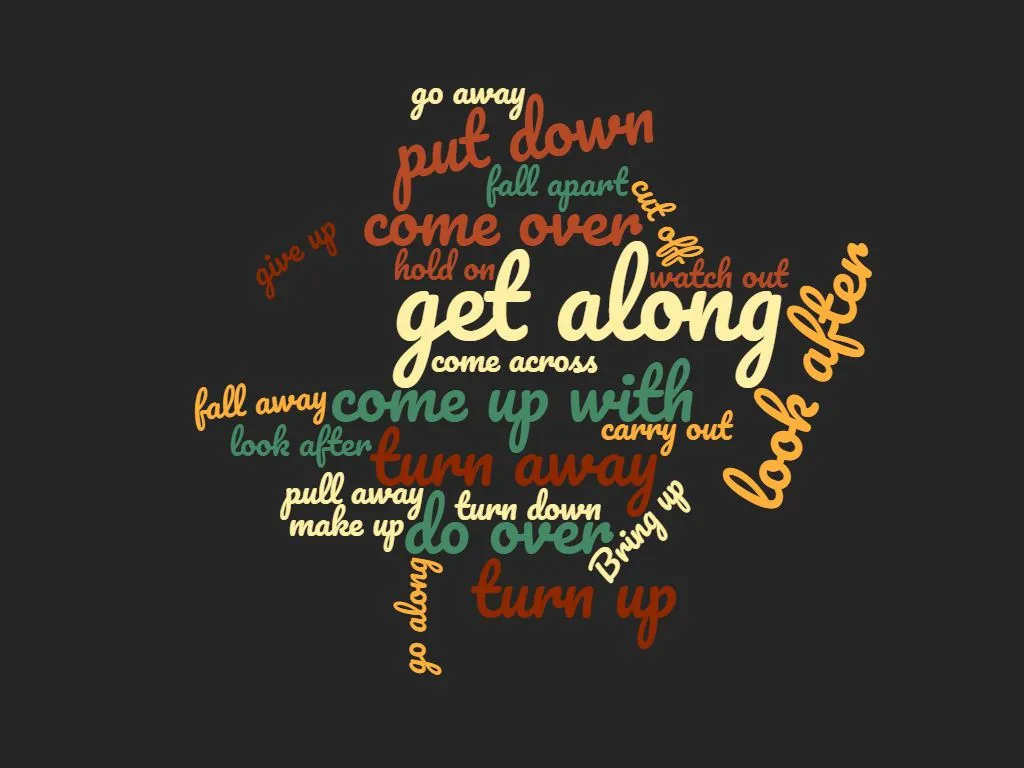An Introduction to Phrasal Verbs

Welcome to the ASA blog! Today we’ll be discussing a common source of frustration for many English learners: phrasal verbs. They can be hard to put up with, but if we keep up our efforts, we can start to pick them up after a while.
Phrasal verbs (also various referred to as multi-word verbs, particle verbs, and compound verbs) are a type of collocation (or common word pattern; more on them in a later blog post) composed of two or more words: one verb and one or more particles¹ or prepositions. Some grammar books separate phrasal verbs (verb + adverbial particle) from prepositional verbs (verb + preposition); if you’re not sure whether a multi-word verb is a prepositional verb or a phrasal verb, in prepositional verbs the preposition and verb cannot be separated² (listen to, break into, get over), but in phrasal verbs the verb and adverb can be separated (bring something up, sort something out, take something on). Other books list all multi-word verbs as phrasal verbs.
English is full of these kinds of verbs (there are thousands of them, and at least hundreds in regular daily use!), and they can be tricky to understand, because their meanings are often very different from the verbs they are composed of. Consider, for example, the phrasal verb turn on: “To turn” is a regular verb meaning to change direction; “on” is a preposition indicating contact with the surface of something. But when we put them together, turn on means “provide electricity to,” “activate,” or “energize”: “Turn on the light,” for example, means “make the light shine by providing electricity to it.”
As a general rule, English speakers use phrasal verbs in informal contexts, notably when speaking. In written or more formal spoken situations they often use “normal,” i.e. one-word verbs³ instead. So someone might say “take off your shoes,” but write “remove your shoes.”
However, some phrasal verbs are so common they have largely replaced normal verbs from the language, even when speaking. The meaning of “turn on the light” is very difficult and awkward to explain in English without using a phrasal verb: it sounds much too formal to say “Please provide electricity to the light!”
Another good example is take off, in the sense used for airplanes. We can easily say “the airplane took off at 5:00,” but you would never hear someone say “the airplane departed from the earth at a high rate of speed and began to ascend into the air at 5:00!”
Another difficulty with these verbs is that many multi-word verbs look very similar to each other, but have very different meanings. Consider, for example, the differences between get up (awaken), get away (depart), get through (endure), get down (duck your head), get around (travel within a particular area), get along with or get on with (have a good relationship with), get by (have enough of something to survive), get up to (do), get over (recover), get at (attempt to communicate), and get away with (escape)! These are all just with “get!”
Finally, many phrasal or prepositional verbs also have multiple meanings. Make up can mean (at least): “invent,” “lie,” “combine to form something,” “prepare,” “reconcile,” “complete,” “apply cosmetics to,” and “compensate for”! When we include slang, idiomatic or jargon-specific use, the number of possible meanings for these verbs only increases.
Given these difficulties (difficulty in understanding meanings, similarity to each other, and multiple meanings), many learners ask if there is an easy or quick way to learn and memorize phrasal and prepositional verbs, but the truth is the only way to acquire them is by study, repetition, and practice. Try to learn each phrasal verb (and even each sense or meaning of a phrasal verb) as its own “chunk,” or piece, of language, the same way you would other collocations. “Put” is very different from put away or put on, so it helps to think of each as a separate verb. There are apps and websites you can use to practice them, but the most effective way to learn them is simply to try to identify them when you hear or read them (movies, TV series and magazines are good for this) or use them when speaking or writing whenever you can (in a conversation or an e-mail, for example).
Grammatically speaking, the good news is most of these verbs are composed of very common verbs, often irregular (like get, go, put, do, have, make, take), and they are easily conjugated: only the verb changes, never the particle: take off becomes took off in the past tense, taken off in the perfect aspect and passive voice, and taking off in the continuous aspect, for example.
There are a few more grammar hints to go over with multi-word verbs, but we’ll do that next time.
Hope this helped! Please contact us if you have any questions or comments, or if you’d like to book a free appointment to see how we can help! Thanks for reading, and we’ll see you next time with another mini-lesson in the ASA Blog!

